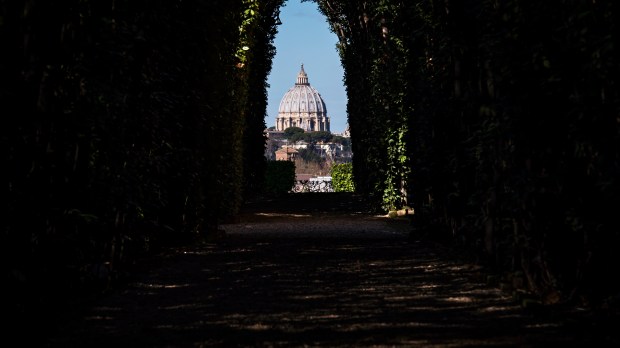In 2019, Pope Francis changed the name of the Vatican archives from “secret” to “apostolic.” The aim was to avoid any confusion about mission of this institution, which is to preserve and disseminate the history of the papacy, not to conceal it. It was called the secret archives because of the Latin secretum, which far from being translated as “secret,” simply means “personal.”
But the archives still possess certain “secrets,” as revealed in a book appropriately titled “Secretum” (Solferino, 2024), in which the prefect of this institution, Archbishop Sergio Pagano, speaks out for the first time. Archbishop Pagano began working in the archives in 1978 and has been its indispensable prefect since 1997. As he approached his retirement, the Italian prelate agreed to talk about the “paper Purgatory,” that is, in the words of journalist Massimo Franco, the Vatican Apostolic Archives.
Exhuming documents relating to Galileo’s trial or Henry VIII’s divorce, shedding valuable light on documents on Pius X’s network of spies, or the “silences” of Pius XII, the “prefect of secrets” brought the important moments of history to life from inside the “bunker” – the nickname of the Vatican archives.
However, Archbishop Pagano also told of other “smaller” histories, made up of anecdotes, astonishing discoveries, and legends that surround the 86 kilometers (around 53 miles) of shelves in the Apostolic Archives.
The not-so-secret archives?
Founded in the 12th century, the Vatican archives were made accessible to a privileged few starting in the 16th century. However, they were not officially opened until 1881, under the pontificate of Leo XIII who, the archivist said, was acting under pressure at the time. The young Italian state had just set up a state archive in Rome, but the existing holdings were too meager. Italy, along with Bismarckian Germany, had thus pushed for access to the papal archives.
Leo XIII’s dilemma was simple: “Either the Vatican Archives opened to the outside world, or they were incorporated into the State Archives in Rome.” Since then, any scholar who so requests can access the popes’ archives. For a long time, the word “secret” was kept in the archives’ title as intended in its original sense, meaning “private.”
The archives in Paris
Other than the Italians after the country’s unification, many others tried to get their hands on the archives. During the sack of Rome, the Holy Roman emperor Charles V’s Lansquenets forced their way in — and left graffiti on the walls that can still be seen today. However, they didn’t damage anything.
The hardest blow to the papal archives was dealt by Napoleon, who had them moved to Paris, where he had planned for a period to install Pius VII and the papacy. Having entered Rome, the emperor’s henchmen, aided by a “traitor” from the Archives, were able to transfer an immense mass of papal documents to Paris, in the Hôtel de Soubise. The documents started being returned in 1815, but with difficulty as “the French tried to hold on to everything they could,” Archbishop Pagano explained.
Nonetheless, the pope was able to count on the determination of his envoys to Paris, notably the great sculptor Antonio Canova, to recover his documents … even if many items are now lost or dispersed. This is the rather ironic case, for example, of the 1809 papal bull that excommunicated Napoleon, now kept in the archives in Vienna, Austria.
The “real” secret archives
In the “bunker,” Archbishop Pagano confided that there is a small collection of documents that cannot be consulted by anyone, and which are actually carefully kept secret. This concerns first and foremost all the documents relating to the conclaves, in particular the results of previous ballots. The ballot papers are burnt, but the “summaries” of the votes remain.
Certain private documents of the pope and cardinals, reports of episcopal elections and decisions concerning Holy See personnel are also not available for consultation. Lastly, secrecy also protects all marriage records and certain documents that the Secretariat of State does not wish to reveal.
What’s not in the archives
The book lists a number of historical facts, but also mentions some of the most far-fetched and persistent legends about what’s supposedly hidden in the popes’ archives. One of the most recurrent stories is that of the presence of gold belonging to the Nazis in the Vatican basement, which is not based on any facts. Or the presence of the Menorah — a seven-branched candle holder — from the first Temple in Jerusalem, stolen by Emperor Vespasian and allegedly retrieved by the popes.
The archives, the Archbishop Pagano assured, do not possess these treasures. Nor do they possess the “Titulus crucis,” the sign bearing the inscription “INRI” that was attached above the Cross, or any “secret” relics of Christ in order to preserve his DNA, as some imaginative minds have claimed. The prefect also pointed out that there are no shelves holding the “skulls of gray Martians.”
On a more serious note, Archbishop Pagano assured that there is “not one line” in the archives concerning what happened to Emanuela Orlandi, the daughter of a Vatican employee who mysteriously disappeared in 1983.
The origin of all these legends? The old archivist pointed to the many novels that have flourished over the centuries, set in the Vatican archives. These works, which base themselves loosely on historical truth — such as Rolf Hochhuth’s “The Deputy” or Dan Brown’s “The Da Vinci Code” — have been met with great success and misinformed generations of readers, Archbishop Pagano said.
“Secretum,” Massimo Franco et Sergio Pagano, Solferino (2024)

